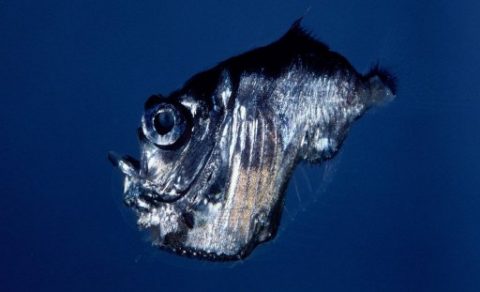
PARIS, France (AFP) — Hatchetfish, tiny “alien-looking” creatures known for an uncanny ability to hide out in open water, use mirror-like scales to deflect and diffuse light to make themselves invisible to predators, scientists reported Wednesday.
Like other silvery fish, hatchetfish are known for using their reflective, aluminium-like skin as a mirror to confuse fellow sea creatures in ambient light.
But scientists have long wondered how they manage to hide in deeper water, where a mirror would reflect incoming searchlight beams and reveal their position to predator fish.
These include eel-like dragonfish, which zap rays of light around in the deep ocean to spot prey.
Now, a research team believe it has shed light on the hatchetfish’s bag of tricks.
“If you look at silvery fish in blue water you are going to see blue water reflecting in front of the fish and you are also going to see blue water behind it, so the fish is going to disappear,” said Alison Sweeney, a researcher at the University of Pennsylvania and lead author of a study published by the Journal of the Royal Society Interface.
“The fish found a way to both simultaneously have this mirror-like property in ambient light, and a stealth technology when it comes to predators looking directly with directed beams,” she told AFP.
For their study, Sweeney and a team flashed a laser beam alternatively onto a mirror, dull aluminium, spectralon (a highly reflective material) and hatchetfish skin in the lab.
The fish’s skin did not reflect the beam straight back, but diffused it in different directions, softening the light, they found.
This effectively reduced the fish’s luminosity, which in real life would help keep it hidden from their hungry enemies.
“A predator has to be twice as close to a hatchetfish to see it” compared with a mirror, Sweeney said.
And that is not the hatchetfish’s only optical trick.
Some of the incoming predator light is redirected downward, toward the ocean floor, through bioluminescent organs in its stomach, the team found.
“You are in big trouble if you get zapped by a search beam so the best option for getting rid of that light is always to dump it downward,” where the predator is less likely to look, she said.
Scientists say they believe it is a unique combination of rectangular and elliptical scales — each reflecting light in a different way — that allows hatchetfish to adapt its light response to different conditions.
The study is the first to investigate how reflecting rather than absorbing light from search beams allows deep-water creatures to camouflage.
Other species in similar conditions hide from the light with transparent bodies, or by changing color to go undetected.







